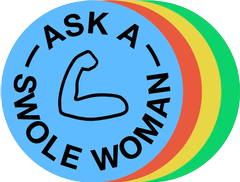Sick of clean eating, perfect gym outfits, and chiseled abs? A Swole Woman is here to help you be healthy, enjoy carbs, and get jacked.
Advertisement
Signed,Eager but it hurts everywhereI am extremely proud of you for finally walking in and doing the damn thing!! But no, working out is not supposed to be like this, soreness-wise.To listen to a lot of people who do or teach exercise, you would be forgiven for thinking that it is. What even is the point of doing a Pilates class, a Pilates class-goer might reason, if not to humble-brag at brunch the next day about how their abs are so sore it hurts to laugh? If it doesn’t hurt to go down stairs the day after a class in learning Beyonce’s “Single Ladies” dance, did we even really LEARN the “Single Ladies” dance?While this is not your specific problem, for the general purpose of discussion, I think it’s worth asking where we get our relationship with soreness from. Soreness and sweat are, for instance, the two eminently stupid pillars of “the meaning of exercise” to fitness professionals who are all too aware that working out has little other immediate noticeable impact except these two discomforts. Those are the only instantly tangible products a trainer or instructor can really sell: If you sweat a lot, you got a good workout. If you’re so sore the next day you can barely move, you got a good workout. Not only did your sweat and soreness demonstrate what a good value you got out of the $40 you spent on the class, but they demonstrated to you how out of shape you are, how badly you needed to be in the class, how overdue you were and how you must be more diligent going forward, returning immediately for another $40 class.
Advertisement
So for those reasons of guilt and needing some sort of immediate payoff, we have been accepting this as normal. And while some soreness can be normal, debilitating regular soreness is not necessary, and it’s definitely not the sure sign we “got a great workout” that it’s usually treated as.Soreness is actually more like the gap between what you did to break down your muscles with exercise (which, despite the fact that lifting heavy is only a few reps and a few sets in a session, can be a lot) and what you gave them to rebuild themselves in the couple of hours and days following in terms of proper food, water, and rest. While it’s easier to overwork a muscle you haven’t used much and get sore, you can actually start at the right pace for your fitness level, recover correctly, and never feel debilitatingly sore again. Feels hard to believe, but it’s true!
I can’t categorically prove that everyone is sore because they are not eating enough after they work out, but call it a hunch. I also can’t categorically prove that the workout that anyone did skewed way too intense for them as the program or the instructor yelled at them to “push” when they were already dying of exhaustion, but call this also a hunch. My hunch in your specific case is that the problem here is the former.Do you have a question about working out, eating, health, or why it rules to lift heavy weights? Send it to swole.woman@vice.com and follow @swolewoman on Instagram.
Advertisement
I have written about this before, when I introduced the following very scientific equations about how we balance workout effort with food, water, and rest, a.k.a. “recovery”:
So you might be going too hard too soon. If that is the case, slow down. But you also need to give yourself recovery tools or you will be sore, and the worse of a recovery job you do, the more sore you will be. It’s worth keeping in mind here “1 billion workout effort units” can be too much for anyone to recover from, even for someone in really good shape. LeBron James, I feel sure, is sore all of the time. But LeBron James will be way more sore if he gets done with a basketball game, doesn’t eat or drink anything, and stays up all night riding Disney rides than if he eats enough to help repair his muscles and then and goes to sleep.To circle back, I feel sure for some reason that your refueling is the problem here, particularly because you mention using “the starting weight for weak women,” which I feel like means you can’t be going all that hard.I know the idea of “just eating more” can be a minefield for a lot of women, but I can tell you that eating enough is the only way all of this is going to work. Your muscles can’t build back up after a session with no food to do it with, and then neither your level of strength nor your physical self is going to change, really. It means you can’t actually add a little weight to the bar each time and get stronger, which is ostensibly the whole point here. If you’re trying to change your body composition without changing your weight by gaining muscle and losing body fat, or trying to maintain muscle and lose body fat, you can’t take care of and protect or build that muscle without food.Effort expended – recovery = soreness
1000 workout effort units – 1000 recovery units = 0 soreness
1 billion workout effort units – 0 recovery units = 1 billion soreness
Advertisement
My partner once framed the idea of not eating substantially after exercising as “wasting a workout.” It blew my entire mind that that was a simple truth to him, when I had spent most of my young life being taught, if anything, the opposite—eating after a workout would undo all the hard work I just did. But he is the one who was raised right: It’s time to make not wasting your workout a priority.So how much are you supposed to eat?I’m going to get into numbers here, so if that’s not your thing skip over this part. But if numbers are your specific trigger I would suggest a) visiting a dietitian or signing up for a nutrition coach who is on board with your strength training goals, and who should be able to help you with pursuing eating without having to deal with body weights or calories (it’s possible!), and/or b) trying to eat an extra serving of protein and a couple extra snacks each day (and if that doesn’t work, please please please try working with a professional). Building strength anew is intense for your body and it’s extremely not the time to underfeed yourself.Usually I shy away from numbers in these situations but here I want to engage with them just to give an example of my own, just to show how mushy they can beYou can see here I can put in my weight, height, age, and activity level and a total daily energy expenditure (TDEE) calculator will pop out a recommended calorie number (and then the recommended protein intake for “athletes,” which you are now, is 0.7-1 grams per pound of body weight. I fill in the rest with carbs and fat as they fall).
Advertisement
But the truth is I will probably actually be living in the recommended caloric range anywhere between the “light exercise” figure and the “heavy exercise” figure, depending on how hard I’m going at the gym. The moderate exercise figure is usually pretty spot-on for me, given that I mostly lie around aside from training three days a week and biking about 10 minutes there and back. But since I’ve been back at the gym after about five months away, thanks to coronavirus, I’ve been eating like a horse, more like the “heavy exercise” number or even more, because my muscles are rebuilding quickly and I’ve just been following those hunger cues.This also may seem like a lot; when I started lifting, I was on the floor about the amount I was “supposed” to eat because it was fully 50 percent more than I usually strove to stick to on any given day, and that was terrifying. But other lifters I followed encouraged fully embracing the process, and I’m extremely glad I did. On the flipside, I’ve personally witnessed people trying out lifting only to balk at the idea of eating more. Eventually they would give up, because without the food part it doesn’t work the way it’s supposed to, and that would make me extremely fucking sad.I was both afraid I would eat in a way that would get out of control and then gain weight in a way that was out of control, but books like Renaissance Woman helped me learn that all of this would probably not happen as quickly or unpredictably as I feared. In past times when I did track my food, I would stick to a given caloric intake for a month or so and check in on my weight every once in a while; if I was losing pounds, I knew I wasn’t eating enough and would bump my intake up by a couple hundred calories. If I was gaining weight faster than I wanted, I could ratchet back by a couple hundred calories.
Advertisement
These numbers are hiiiighly dependent on your personal biology, which is why no one should take mine for their own. For instance, if you are much smaller, the numbers will be lower; if you are higher in body fat, experts often recommend basing protein intake on lean body mass as measured by a doctor or body scanner, and not overall body weight (to the tune of 1-2 grams of protein per pound of that lean body mass, depending on how hard you’re working).All these numbers suggest that you track your food and calories, which I used to do diligently and still find helpful when I’m trying to either build muscle or lose body fat. I don’t often do it anymore, because I have a more intuitive sense of my hunger cues and have unlearned a lot of self-shaming behaviors about food. But that was years of work, to get to that place, and could be years of work for anyone.“Figuring out how much to eat” seems like something we should be able to do without getting multiple professionals involved. But food is nothing if not profoundly fraught, politically and personally and logistically; even our government’s theoretical best stab at giving us healthy guidelines is lorded over by lobbyists.If any of this feels scary or contradictory for you, whether the problem is eating a lot more (especially when maybe, as is the case for a lot of women, you think it’s your duty to be perpetually losing weight) or food/body-related numbers, I want to strongly encourage you to both take this seriously and feel reassured there is nothing Wrong with you for wanting assistance with this. But mostly I’m begging you not to try and do strength training while skipping over the whole other half of the process. Make sure you eat, sleep, drink enough water, and aren’t too stressed out all of the time so that you can actually enjoy this.Disclaimer: Casey Johnston is not a doctor, nutritionist, dietitian, personal trainer, physiotherapist, psychotherapist, doctor, or lawyer; she is simply someone who has done a lot of, and read a lot about, lifting weights.You can read past Ask A Swole Woman columns at The Hairpin and at SELF and follow A Swole Woman on Instagram. Got a question for her? Email swole.woman@vice.com.

